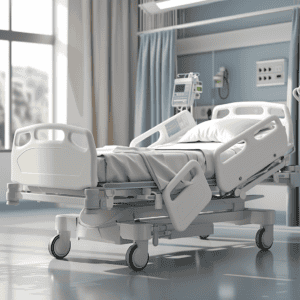Understanding Your Risk: Common Bike Accident Injury Types and Prevention
Last updated Monday, April 1st, 2024

When a bike accident occurs, the immediate concerns revolve around the injuries sustained and the steps to follow. If you’ve been involved in a cycling collision, understanding the possible bike accident injury types is essential for effective treatment and recovery. This article covers the spectrum of injuries you may face, the importance of immediate medical attention, and guides through the post-accident process including legal options for compensation and claims. Equipping yourself with this knowledge, you can navigate the road to recovery with clarity and confidence.
Key Takeaways
- Bicycle injuries vary widely, ranging from minor abrasions to serious conditions like head and spinal cord injuries that could lead to long recovery periods or permanent disabilities.
- Immediate medical attention is critical after bicycle accidents due to the potential for severe and sometimes hidden injuries, necessitating emergency care and, in some cases, prolonged treatment and rehabilitation.
- Legal aspects following a bicycle accident can include filing insurance claims and lawsuits, with victims entitled to compensation for damages including medical expenses, lost wages, and pain and suffering.
Have You Been Injured in a Bicycle Accident?
Get Your Free Injury Case Review
Hire an experienced bicycle accident lawyer that knows what needs to be done. The minute you sign with Skaug Law – we start working.
Navigating the Aftermath: Types of Bicycle Accident Injuries
Our roads are a tapestry of vehicles and cyclists. Each day, bicycle riders navigate traffic, hoping to arrive safely at their destinations. But accidents do happen. Injuries sustained in bicycle accidents, often referred to as bicycle injuries, are quite diverse, ranging from common bicycle accident injuries such as:
- minor scrapes
- bruises
- cuts
- sprains
- strains
- fractures
- head injuries
- spinal cord injuries
The array of potential injuries cyclists may face is broad and can be quite alarming.
The aftermath of a bike accident can be a tumultuous period. Broken bones, head injuries, and soft tissue injuries frequently occur as a result of bicycle accidents. These injuries can be severe and may require immediate medical attention. These injuries can profoundly affect a cyclist’s life, perhaps necessitating a lengthy recovery period or resulting in permanent disability.
The Threat to Your Head: Traumatic Brain Injury and Concussions
One of the most severe injuries cyclists can suffer is a traumatic brain injury, often resulting from a head injury. This can occur from sudden impacts to the head or even without a direct impact, as the force of a collision may cause the brain to strike the inside of the skull, leading to a range of symptoms from headaches and dizziness to cognitive difficulties.
For defense against head injuries, the bicycle helmet is a simple yet effective tool. Using a helmet can significantly decrease the chance of head injuries by 85% and serious brain injuries by about 40%. Helmets are particularly effective across all ages, reducing the risk of head, brain, and severe brain injury by 63 to 88%.
When the Spine Suffers: Understanding Spinal Cord Injuries

- varying degrees of paralysis
- loss of sensation
- loss of motor function
- loss of bowel and bladder control
It is important to seek immediate medical attention if you suspect a spinal cord injury after a bike accident.
Such injuries can have extensive implications. Severe spinal cord injuries may result in paralysis and require lifelong medical care. These scenarios underscore the need for preventative measures and adherence to safe riding practices.
More Than Skin Deep: Road Rash, Soft Tissue, and Internal Injuries
Apart from the spine and head, other areas of the body are also at risk during a bike accident. Some common injuries include:
- Road rash
- Deep lacerations
- Fractures
- Dislocations
These injuries can be painful and may require medical attention. It is important to take proper safety precautions while biking to minimize the risk of accidents.
However, the extent of injuries can exceed superficial damage. Crashes may also result in internal bleeding and organ damage. Soft tissue injuries can affect muscles, ligaments, and tendons, requiring an extended recovery period. These injuries emphasize the need for prompt medical care after a bicycle accident.
First Response: Seeking Medical Attention Post-Accident
Getting checked by a medical professional right after a bicycle accident is of utmost importance. Injuries can range from minor abrasions to major trauma, including hidden injuries like internal bleeding or traumatic brain injuries that are not immediately apparent.
While you might feel fine immediately after an accident, some injuries might not be apparent initially due to shock or adrenaline. Seeking immediate medical help after a bicycle crash is vital to identify and treat potential hidden injuries, which could lead to complications or become life-threatening.
Emergency Care: Visiting the Emergency Department
The moments following a bicycle accident can be chaotic and disorienting. In these moments, victims often find solace in the emergency room. Emergency departments play a critical role in handling the immediate needs of pedal cyclists who sustain injuries in accidents.
Visiting the emergency room right after a bicycle accident ensures that victims receive immediate treatment by emergency room physicians, who are vital in assessing and advising on the necessary follow-up care. These medical professionals have the expertise to assess your situation quickly and administer the necessary treatment.
Follow-Up Treatments: From Multiple Surgeries to Rehabilitation
The road to recovery following a severe bicycle accident can be long and challenging. Recovery from severe bicycle accident injuries often necessitates multiple medical interventions, including medical treatment such as surgery and rehabilitation, to restore health and function.
Consider one individual’s journey, which included:
- a hip fracture needing surgical intervention with a pin and plate
- a subsequent challenging recovery period
- a strenuous rehabilitation process
- learning to walk again
- addressing muscle atrophy through various forms of physical therapy
- culminating in a return to cycling.
Legal Roadmap: Navigating Insurance Claims and Legal Options
Recovering from a bicycle accident isn’t solely a physical process. There’s also a legal aspect to consider. The timeframe for filing a bicycle accident claim is governed by state law, usually allotting about two years from the accident date to file a lawsuit, while insurance claims typically require prompt attention and must be filed much sooner.
It can be overwhelming to navigate the legal complexities following an accident. It is advisable to seek legal consultation promptly after a bike accident, and prior to discussing the accident with insurance companies or the police, to ensure that the claims process is handled correctly.
Documenting the Scene: Police Report and Insurance Information
A critical step after any bicycle accident is filing a police report. This report provides an official record of the incident, which can be pivotal when filing an insurance claim.
Additionally, gathering contact and insurance information from all parties involved is crucial. If the driver is cooperative, the cyclist should obtain their:
- Name
- Contact details
- Date of birth
- Insurance information
- Vehicle registration details
In addition, photographs of the crash scene, bicycle, equipment, injuries, driver’s vehicle, clothing or shoes, motor vehicles involved, and any road damage can be valuable.
Exploring Compensation: Understanding Your Legal Options

To calculate the compensation amount, various damages from the accident are considered, including:
- Medical bills
- Cost of medical devices
- Therapy
- Lost wages
- Emotional trauma
- Pain and suffering
If insurance settlements are insufficient, civil lawsuits may provide a necessary avenue for victims to receive fair compensation.
Gear Up: Preventative Measures to Reduce Risk of Bike Accidents
The principle of ‘Prevention is better than cure’ is especially applicable here. When it comes to bicycle accidents, this adage holds particularly true. Ensuring correct cycling form, such as properly adjusted handlebars, is crucial to prevent neck and back pain. Moreover, proper alignment and posture on the bike can reduce the risk of injuries that indirectly affect the spine.
Another preventative measure includes mitigating potential discomfort from long cycling periods. Cyclists can experience urogenital problems such as numbness or pain in the genital or rectal areas after extended periods of riding. Adjusting saddle position and taking regular breaks can help prevent and alleviate symptoms of urogenital discomfort.
Protective Wear: The Role of Bicycle Helmets and Pads
Helmets and pads for cyclists serve a similar protective role as seatbelts in cars. Head injuries can range from minor cuts to severe traumatic brain injuries, and wearing a helmet can significantly mitigate these risks. Wearing a bicycle helmet significantly decreases the likelihood of sustaining minor injuries and increases the chances of escaping without any visible injury in the case of an accident.
Helmets not only protect the brain but also shield the upper part of the face from potential trauma. Research indicates that helmet usage is effective in protecting against injuries in various types of bicycle accidents, including single bicycle crashes.
Safe Riding Habits: Tips to Avoid Common Hazards
Alongside protective gear, cultivating safe riding habits is equally vital in preventing accidents. Ensure your bike is equipped with front and rear lights for low visibility conditions, such as night, fog, or rain. Wearing bright, reflective clothing can significantly increase a cyclist’s visibility to other road users.
Always use hand signals when turning or stopping to inform other road users of your intentions. Follow all traffic signs and signals, and ride in the direction of traffic to reduce the risk of collisions. And remember, regular bike maintenance is key to preventing mechanical failures that can cause accidents.
The Human Impact: Personal Stories of Recovery and Resilience
Behind each bicycle accident statistic, there lies a human story. These are individuals who have endured:
- traumatic brain injuries
- prolonged effects on cognitive function
- sensory perception
- emotional stability
But amid this adversity, they have shown remarkable resilience.
One individual’s journey showcases the power of a positive mindset during recovery, maintaining focus on healing rather than the negative impact of the injury. Upon recovery, the individual was able to return to an active lifestyle, including cycling, valuing exercise’s role in their life despite previous accidents.
What are the most common injuries in a bike accident?
The most common injuries in a bike accident are head injuries, accounting for over 60% of bicycle accident fatalities. Wearing a helmet can significantly reduce the risk of head injury by up to 85 percent.
What is the trauma after a bicycle accident?
The trauma after a bicycle accident can result in psychological effects such as post-traumatic stress disorder (PTSD), anxiety, and intrusive thoughts about the events leading up to the injury, which can have long-lasting consequences.
How do you treat a bike accident injury?
To treat a bike accident injury, first, rest the injured area. Then, apply ice for 15 to 20 minutes every couple of hours to reduce swelling, followed by compression with a brace or wrap to minimize mobility and swelling.
How can a helmet protect me in a bicycle accident?
Wearing a helmet can greatly reduce the risk of head injuries, including traumatic brain injuries. It provides essential protection in the event of a bicycle accident.
What should I do immediately after a bike accident?
Seek immediate medical attention, document the accident scene, and consider contacting your lawyer for further advice.
What are the most common injuries in a bike accident?
What is the trauma after a bicycle accident?
How do you treat a bike accident injury?
How can a helmet protect me in a bicycle accident?
What should I do immediately after a bike accident?
What are the most common injuries in a bike accident?
The most common injuries in a bike accident are head injuries, accounting for over 60% of bicycle accident fatalities. Wearing a helmet can significantly reduce the risk of head injury by up to 85 percent.
What is the trauma after a bicycle accident?The trauma after a bicycle accident can result in psychological effects such as post-traumatic stress disorder (PTSD), anxiety, and intrusive thoughts about the events leading up to the injury, which can have long-lasting consequences.
How do you treat a bike accident injury?To treat a bike accident injury, first, rest the injured area. Then, apply ice for 15 to 20 minutes every couple of hours to reduce swelling, followed by compression with a brace or wrap to minimize mobility and swelling.
How can a helmet protect me in a bicycle accident?Wearing a helmet can greatly reduce the risk of head injuries, including traumatic brain injuries. It provides essential protection in the event of a bicycle accident.
What should I do immediately after a bike accident?Seek immediate medical attention, document the accident scene, and consider contacting your lawyer for further advice.

